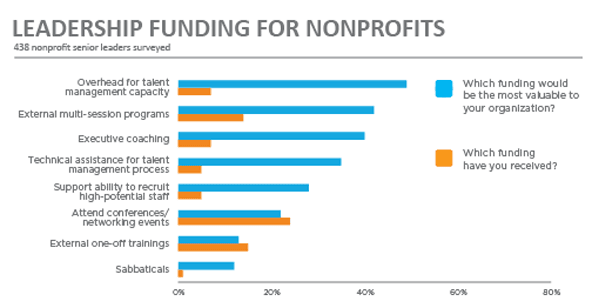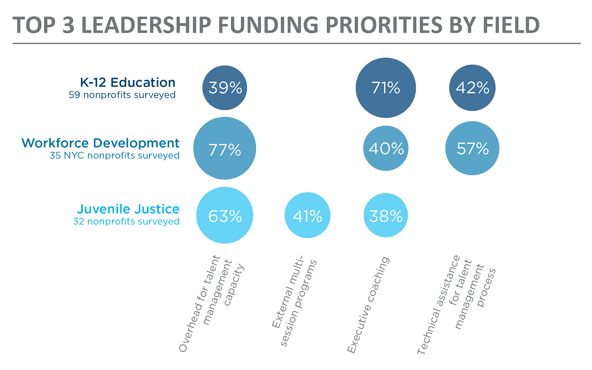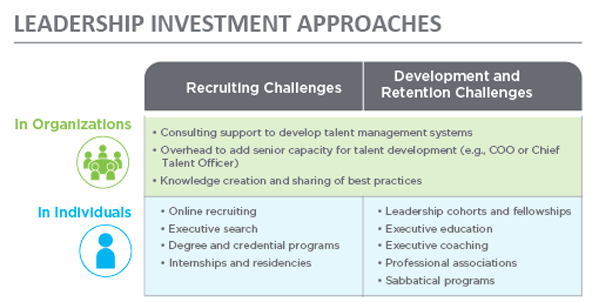Most foundations understand the need for their grantees to have strong leaders who can make the most of the support they receive. In fact, nearly two-thirds of the 50 foundation leaders who participated in a 2015 Bridgespan survey ranked leadership development as a top priority. Yet a separate survey of 438 nonprofit leaders highlighted important differences between the support nonprofits feel they need to cultivate strong leaders and the support they actually receive.
For example, rather than external trainings and conferences—leadership activities funders typically support (see chart below)—half the organizations we surveyed prioritized internal talent development to help employees on the job. Few nonprofit organizations reported receiving this support, and we believe this is a major cause of nonprofits’ most pressing leadership issue: CEO succession planning.
 Leadership development funding—what nonprofits need vs. what they receive.
Leadership development funding—what nonprofits need vs. what they receive.
The good news is that many funders seem open to new thinking. Fewer than one in four funders reported high confidence in their leadership investment decisions, although their commitment to leadership funding remained high—roughly 40 percent planned to increase their financial support in the future.
Given this, the time is right for funders to consider how they can make the most of the dollars they invest. To do this, they must first answer two important questions: What is at the root of the leadership challenges grantees face, and what is the right investment to address those problems?
What is the core challenge?
Are you enjoying this article? Read more like this, plus SSIR's full archive of content, when you subscribe.
Identifying leadership problems that need fixing sounds simple, but it isn’t always so. The root cause could originate in a number of places. It could stem from recruiting the wrong people or missing talent development opportunities, for example, or from failing to create an environment that supports and retains leaders for the long term.
In our research, the types of support nonprofits most value differed by field (see chart below). K–12 education nonprofits prioritized executive coaching. While our survey didn’t ask their rationale, one might imagine that the highly political nature of education organizations might motivate leaders to need one-on-one support. By contrast, large, multiservice workforce development organizations in New York City prioritized unrestricted funding to improve their ability to support and cultivate leaders across the many levels of their organizations.
 Leadership funding priorities differ by field.
Leadership funding priorities differ by field.
To understand a grantee’s greatest need, funders need to engage—through interviews, focus groups, and surveys—those who understand the leadership challenges best: nonprofit staff, boards, recruiting professionals, and other field experts.
What might this look like? Take for example a group of more than a dozen of the largest and most influential Jewish funders that, faced with accelerating senior leadership retirements, sought to identify investments they could make in the next generation of leaders. These funders interviewed senior executives, emerging leaders, and search executives in the Jewish nonprofit field, and gathered input on barriers organizations faced in finding the leaders they needed. They then created three “leadership pipeline” initiatives:
- A CEO onboarding program with customized support to help new CEOs succeed in their first year
- A campaign to establish field-wide criteria for what defines a great place to work and to educate organizations about these best practices
- A campaign to engage board members and donors on how steward effective leadership development within Jewish nonprofits
“We started the process thinking we knew what was needed and were looking for help in designing it,” says Rachel Monroe, president and CEO of the The Harry & Jeanette Weinberg Foundation. “It wasn't until we asked senior and emerging leaders in the field what they needed that we realized our initial assumptions were not quite right … And we are continuing to gather feedback from the field as we do this work.”
What is the right set of leadership investments?
From a list of more than 1,000 nonprofit leadership investments, we categorized a number of approaches funders can use to address the root cause of any leadership challenge they uncover, including executive education and fellowships for individuals, and capacity and consulting support for organizations to better develop talent.
 Examples of approaches funders can use to address leadership challenges.
Examples of approaches funders can use to address leadership challenges.
The potential efficacy and cost of various leadership investments varies widely. Thus, funders must not only identify the solution or mix of solutions that will best meet the challenges at hand, but also consider the most cost-efficient way to deliver those solutions so that they can serve the most people. Executive coaching can cost half as much as an executive education program, fobr example, but coaching may be as—or more—effective, depending on individual needs.
As an example, the team at Tiger Foundation, which aims to break the cycle of poverty in New York City, decided to support leadership development among some of its existing grantee staff after realizing that—despite investments in executive training at Columbia University—grantees were struggling to attract, develop, and retain people that could ultimately take on leadership roles.
“High-quality executive training programs like Columbia’s are great, in that they are already established, highly regarded, and relatively cost-effective,” said Tiger Foundation President Charles Buice. “However, [investing in individuals] does not preclude the need to make more sizable investments at the organizational level, since institutional investments might impact 100 leaders over time and transform the organization into the kind of place that has human capital development as part of its DNA.”
Tiger continued to provide funding to individuals to attend Columbia, but also offered new funding for external consultants at AchieveMission to help grantees grow leaders in-house. “We supported these exemplary organizations to embed tailored systems that helped them identify the most promising future leaders and develop them in the most effective way,” said James Shepard, AchieveMission’s CEO.
Closing the gap
Investing in the development of strong and dynamic leaders is a worthy priority for any foundation. Yet, the gap our survey discovered between funders’ good intentions and grantees’ needs prevents funders from realizing their goals for building stronger nonprofit and field leaders. Closing that gap will require that funders take more time to dig deeply into the root causes behind individual grantees’ leadership challenges. Leadership clearly matters when it comes to achieving impact. It’s an investment worth making wisely.
A longer version of this article appears on the Bridgespan website.
Support SSIR’s coverage of cross-sector solutions to global challenges.
Help us further the reach of innovative ideas. Donate today.
Read more stories by Betsy Haley Doyle, Libbie Landles-Cobb & Kirk Kramer.

